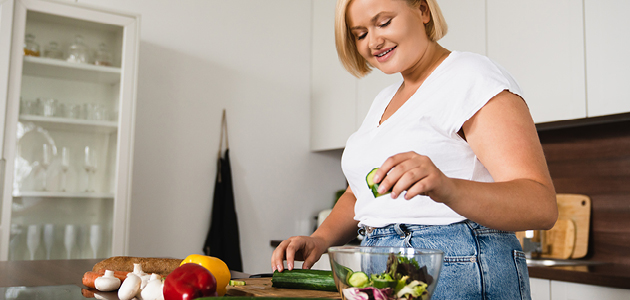Dr. Akua Woolbright, Nutrition Program Director for Whole Cities Foundation
In managing your diabetes this holiday season, we encourage you to bring your health into the holidays with you. Being intentional and mindful of healthy habits can help you maintain your health and wellness goals.
The holiday season is here, and eating, drinking, and being merry are part of the festivities that help make this time of year warm and memorable. We look forward in anticipation of all the different foods we will have to eat. We each have our favorites, whether it’s turkey and dressing, ham, macaroni and cheese, mashed potatoes, candied yams, eggnog, hot wassail, dinner rolls, pie, gingerbread houses, or holiday cookies. With so much bounty at every turn, it is only natural for many of us to relax our healthy eating and lifestyle habits.
However, holiday eating is not our only concern. While this time of year is filled with joy and cheer for many of us, it can be extremely stressful and depressing for others. The upcoming holidays offer a seemingly perfect escape and opportunity to revert to the traditions that bring feelings of comfort – which includes consuming decadent dishes.
When we think beyond Thanksgiving and Christmas to consider other holidays and celebratory events like Halloween, Hanukah, Kwanzaa, New Year’s, the Super Bowl and Valentine’s Day, our healthy habits can easily be thrown out of balance from October through mid-February. You can change that by taking the time to cut through all this noise and become more intentional about how you care for your body. I want you to start by rethinking your holiday habits.
Double down and commit to practicing healthy habits now that will keep you from falling off the wagon over the next couple of months. Decide on the specific practices you will implement. You might decide to drink a green smoothie for breakfast, eat a jumbo vegetable soup or salad before every meal, choose smaller portions, load up on vegetable sides, eat a healthy meal before heading to a party, skip dessert, drink fewer alcoholic and fruity beverages, walk after heavy meals, cycle, jump rope, lift weights, practice yoga, join an online Zumba or dance class, meditate, attend a
virtual weight loss or wellness support group, or take an online course on mindfulness. The key is to add green and colorful produce to every meal, eat less, practice mindfulness and move more.
As part of this process, I challenge you to be more aware and in tune with your body. Identify the emotions that could contribute to us becoming even more disconnected from our physical and emotional bodies. It doesn’t matter if we feel happy, busy, stressed, depressed or distracted; all of these emotions can lead us to eat foods in response to emotional triggers rather than physiological needs. Think about when you are feeling emotional. What foods do you crave? Most of us don’t crave fresh produce. Instead, we are drawn toward foods that are high in calories and low in nutrients, such as ice cream, chocolate or a bag of chips. These foods trigger the brain’s reward center and give us a temporary sense of euphoria. I want you to be mindful of this and take actionable steps to curb those urges.
When eating, ask yourself the following questions:
- Is your hunger the result of feeling stressed, upset, bored, lonely or sad?
- Do you eat absent-mindedly without paying attention to satiety or your body’s nutritional needs?
- Do you frequently make impulsive food choices that you later regret?
- Do you feel guilty after eating?
- To cultivate healthy eating habits, learn to recognize real hunger, connect to the sense of fullness after eating, and be fully present when eating. A simple way to do this is to slow down. It takes 20 minutes for the gut to signal the brain that it has had enough to eat.
- This level of awareness will help you maintain a lifetime of healthy habits and mark the end of yo-yo dieting. To put this into practice:
- Determine if you are an emotional eater. Track the times you eat in response to your emotions versus real physiological need.
- Observe your emotions and try to define them. Can you identify why these emotions are surfacing?
- Note whether you tend to have certain emotions more than others. Are your eating habits connected to how you feel?
- Find ways to clear your emotions (i.e., working out, journaling, connecting with loved ones, talking with a therapist).
- By being real with ourselves, creating and implementing a plan, and staying mindful and aware of our emotions, we can enter this holiday season and beyond with a renewed outlook on our wellness journeys. And that is truly the best gift you could give yourself.
 This article originally appeared on wholecitiesfoundation.org. Written by Dr. Akua Woolbright, Ph.D., is an authoritative expert on nutrition with a passion for helping individuals and communities achieve healthier lives. She leads Whole Cities Foundation’s Let’s Talk Food nutrition program.
This article originally appeared on wholecitiesfoundation.org. Written by Dr. Akua Woolbright, Ph.D., is an authoritative expert on nutrition with a passion for helping individuals and communities achieve healthier lives. She leads Whole Cities Foundation’s Let’s Talk Food nutrition program.
Foresters Financial and its employees, agents and life insurance representatives do not provide, on Foresters behalf, legal, estate, health, medical or tax advice. Consult your physician or licensed healthcare professional for any questions or information about your medical care.
The author of this article and Whole Foods Market Foundations are solely responsible for the content therein. Foresters Financial makes no representations or warranties with respect to the accuracy or completeness of the contents of this work.
421480 CAN/US (01/23)




